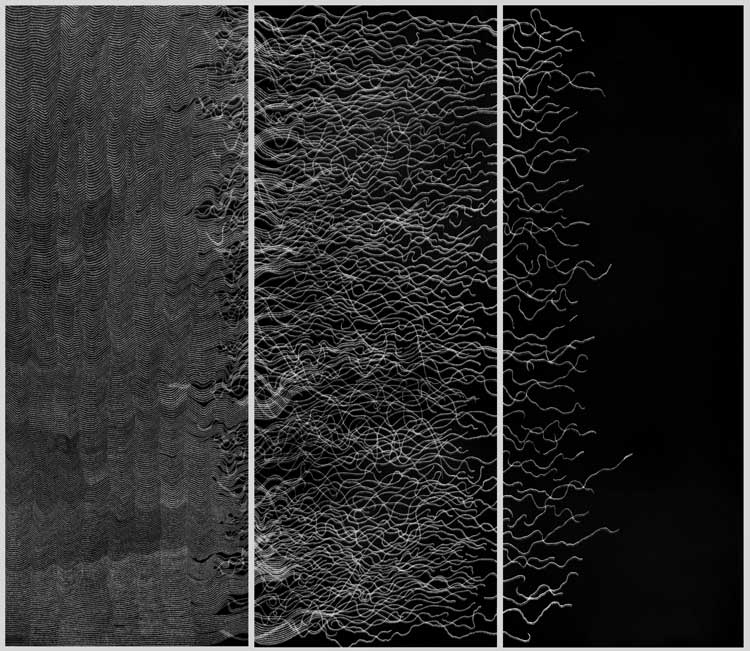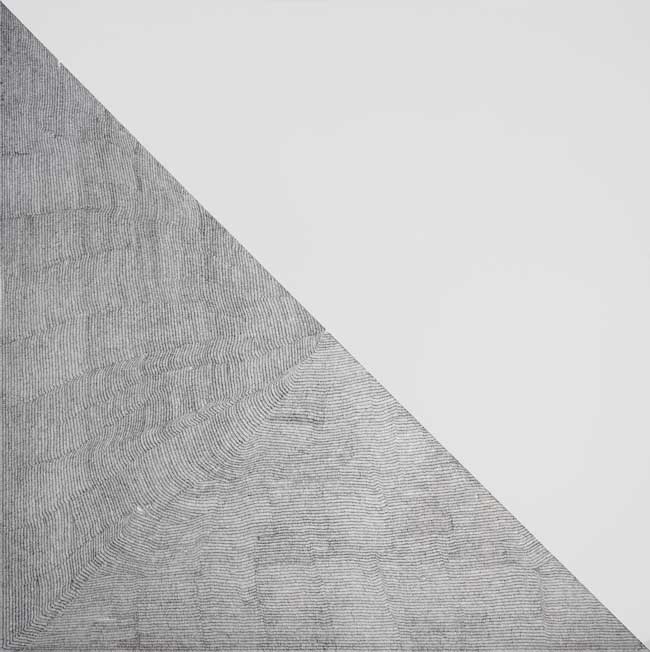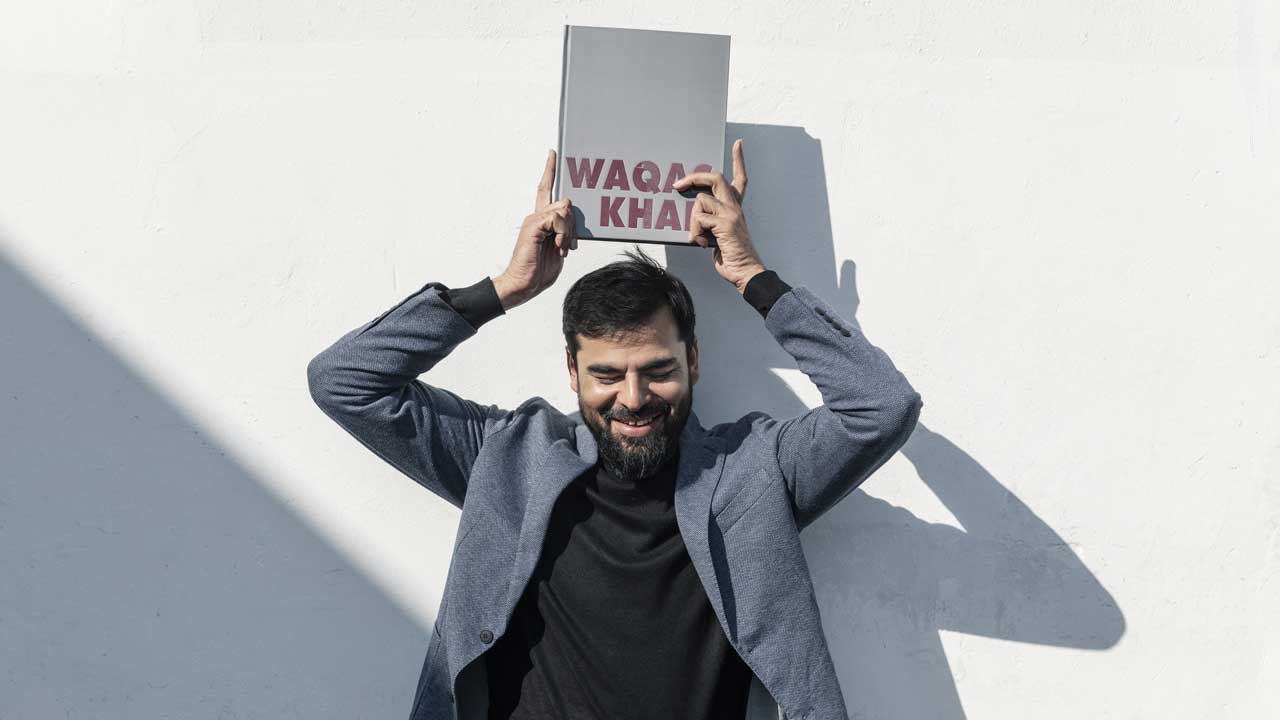Waqas Khan’s art reflects traces of ancient symbols related to both history and the process of evolution. Khan exhibits extraordinary patience throughout his artistic journey, which, despite seeming infinite, ultimately comes to an end. His creations consist of numerous marks, lines, and dots that intertwine and transform with a pen on paper. Habib Bank Limited Pakistan (HBL) recently emphasized the importance of artist Waqas Khan by releasing a hardback cover book entitled A Man with A Pen: The Sentient Art of Waqas Khan. Spread over 150 folio sized, thick and slightly textured papers, this publication celebrates Khan’s global influence in the art scene and includes contributions from art critics and writers, including Salima Hashmi, Jonathan Jones, Zohreen Murtaza and Asad Hayee, who take turns to present their perceptions of Khan’s creative process along with a visual exploration of his studio in Lahore.
Khan’s partnership with HBL and publishing collaboration with White Turban Art Consultancy represented a significant point in his investigation of dimension, recollection, and awareness. Tasked with designing artwork for HBL’s new building in Karachi, he engaged with the architecture and atmosphere of the environment with the intention of not simply decorating the walls, but to seamlessly integrate his art into the essence of the building, evoking a collective memory for its daily inhabitants. This introspective approach later on influenced his publication in question, where his artistic journey is documented in the book.1 Through the creation of a physical archive encompassing his life and work, Khan contemplated the development of his artistic practice, utilizing the book as a means to foster a continuous conversation between the purview of events.
Jonathan Jones, notable British art critic argues that labelling Waqas Khan’s art as abstract might seem appropriate, but overlooks its true depth as precisely placed dots and lines mark a moment of revelation, as if the universe’s mysteries were laid bare, freed from form and colour — marking a first step toward understanding creation. Khan’s art reveals its essence up close. Production cannot truly capture the intricate balance of the expansive and the minuscule in his work. From afar, his canvases seem like vast, delicate fields, but up close, they become interlacing of meticulous marks and lines, expanding and contracting with rhythm. To acknowledge the scope of his labor, one must lean in to see the extraordinary detail, with demanding composure, and affinity.
In her article, Salima Hashmi captures the essence of Waqas Khan’s artistic vision, highlighting the way his work draws viewers into a contemplative space of solitude. She emphasizes the viewer’s active role in tracing the intricate journeys of his marks and dots, which can shift inwards or extend across expansive, silent areas. A powerful reflection on Khan’s piece Hidden in Stratum, showcased at the 2022 Toronto Biennial, further elucidates his innovative approach. The work transcends traditional Eastern or Western frameworks, stationed between miniature painting and minimalist abstraction. Similar to a biological organism developing from a solitary cell, the distinct marks in Khan’s works merge into more significant shapes, representing the intricate connections among individuals within a community while emphasizing the power discovered in relationships that span differences, rather than undermining them.


Fiction writer Sara Khan presents a fictional narrative for Waqas Khan’s journey in her chapter “Quest”, as a tapestry woven from failures and setbacks, each contributing to his evolution as an artist. His path to joining the National College of Arts (NCA) was fraught with challenges, taking three years filled with perseverance and uncertainty. Born in Akhtar Abad, Okara, Khan’s artistic journey began in a printmaking program at NCA, where he explored various mediums, including sculpture, architecture, miniature painting, weaving, and dance.2 This experimentation enriched the complexity of his work, though he muses that his choice to attend NCA was less about a strategic pursuit of skill and more about its welcoming atmosphere. Inside the famed walls of NCA, he cultivated a minimalist aesthetic defined by meticulous dots and lines, frequently less than a centimetre in size, forming a distinct visual language that persists in its evolution, defying straightforward categorization even for experienced art critics. Khan’s artistic journey has evolved from a focus on geometry and repetition to a more liberated expression in his recent creations, yet his newer pieces reflect a poetic sensibility, inviting comparisons between prose and poetry, both conveying meaning yet differing in structure and style. While prose prioritizes logical content, Khan’s art embraces the sensitivity of visual expression, crafting intricate compositions that resonate with deeper sensations.
A Man with A Pen: The Sentient Art of Waqas Khan celebrates the process of mark-making, which weaves a narrative rich with natural patterns of spirals, tessellations, and Fibonacci sequences that reflect a meditative exploration of existence and transcends conventional definitions and jargon related to the art colloquium. Waqas Khan challenges viewers to engage with the layered meanings embedded within each meticulous stroke while resisting categorization and urging recognition of the profound depth and humility in his work, which mirrors neither Sufic mysticism nor abstract expressionism but is instead a reflection of his journey, which cannot be contained within a boundary. To categorize his work is to exoticize his practice and present it inside a pristine white cage made with foreign bars.
Emphasizing instinct over spirituality, Khan attributes his creative impulses to the cultural and linguistic memories of his upbringing rather than a deliberate pursuit of artistic transcendence.3 He sees the dots and lines in his compositions as vibrant characters engaged in a dynamic dance, rooted in discipline and meticulous attention to detail. Khan enjoys the diverse interpretations of his art, welcoming interactions with gallery visitors and valuing each viewer’s perspective as an integral part of the evolving dialogue around his work. For him, once an artwork is completed, it belongs equally to the audience, allowing for a rich discourse on sentiments and philosophy.

The book also contains a pop-up section where prominent events from Khan’s career are presented in a timeline. His works are included in the permanent collections of esteemed institutions such as the Victoria and Albert Museum, the British Museum, and the Manchester Museum, and have been showcased widely around the world. Key locations for his exhibitions include the Irish Museum of Modern Art (IMMA), the Saudi Arabia Museum of Contemporary Art (SAMoCA), and the National Museum of Sculpture in Spain, among numerous others. In addition to the 2022 Toronto Biennale, he has taken part in major events like Asia NOW Paris, Frieze London, Art Basel Hong Kong, and the 57th Biennale di Venezia in Italy. This publication with HBL has benefited Khan’s project “Nathuu”, which he has co-established with his wife, Bushra Waqas Khan, which is a social initiative that brings happiness to children throughout Pakistan by providing art education, particularly to those facing challenging socio-economic circumstances, enabling them to realize their creative abilities.
Man with A Pen: The Sentient Art of Waqas Khan is published by Habib Bank Limited and managed by White Turban Art Consultancy (2024).
Cover image courtesy and copyright, Aun Raza.
References:
Hashmi, S. (2017). Palette: Ways of Navigating Waqas Khan. Dawn https://www.dawn.com/news/1363319
Waqas Khan at Arsenal Contemporary Toronto, Toronto Biennial of Art. June 2022 https://torontobiennial.org/exhibition/waqas-khan-at-arsenal-contemporary-toronto/
- “Curator’s Note,” Asad Hayee, p.3.
- “Quest,” Sara Khan, p.101.
- “The Search For Lived Cultures In Junbish,” Zohreen Murtaza, p. 61.
Sousan Qadeer
Sousan Qadeer is an visual artist, writer and educator from Lahore, Pakistan. She completed her Bachelor of Fine Arts from National College of Arts, majoring in Printmaking, and has seven years of teaching experience at Lahore Grammar School as an Art and English teacher. She completed her Master of Art and Design Studies at Beaconhouse National University, Lahore in 2023 and currently works there as a visiting faculty. Qadeer has written several articles published on local and international platforms. She explores the shifting power dynamics of the viewer, the medium and the creator in her artistic practice. She experiments with mathematical fields of combinations, probability and permutations to create analogous generative art through patterns.



There are no comments